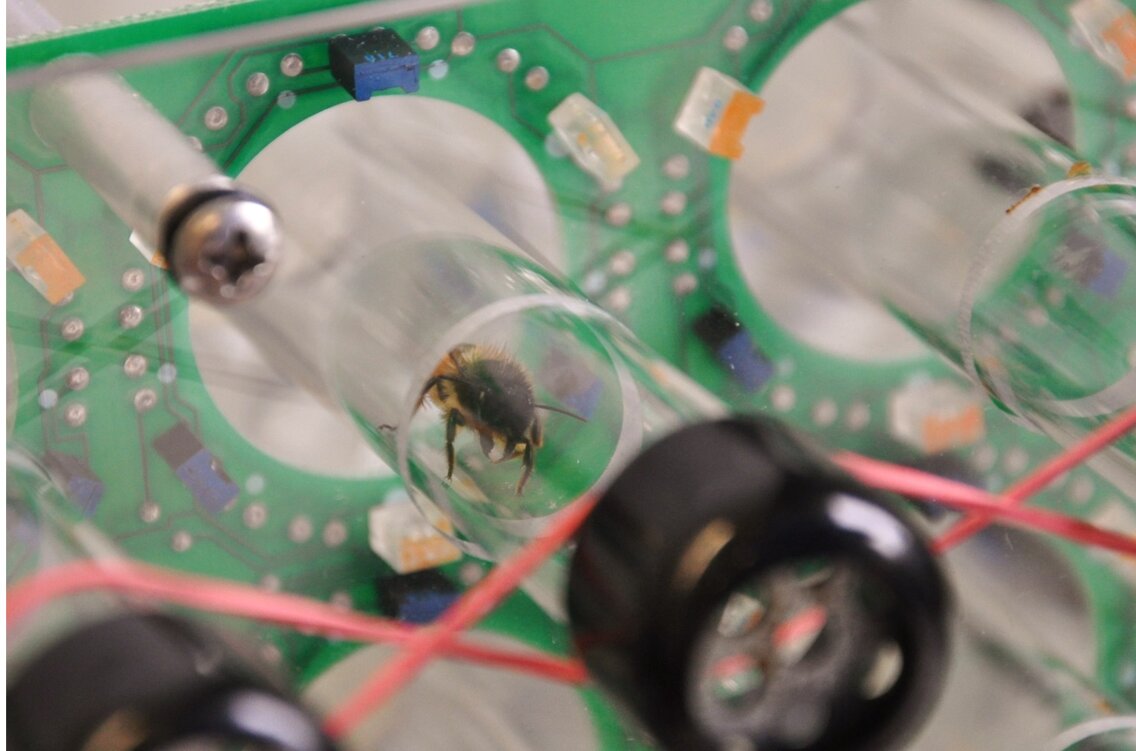#Solitary bees are born with a functional internal clock—unlike honeybees

“#Solitary bees are born with a functional internal clock—unlike honeybees”

Social insects like honeybees and hornets evolved from solitary bees and wasps, respectively. A common trait of many social insects is age-specific behavior: when they emerge from the pupa, workers typically specialize in around-the-clock tasks inside the darkness of the nest, starting with brood care. But they gradually shift towards more cyclic tasks away from center of the nest as they get older—culminating in foraging outside, exclusively in daylight, towards the end of their life. Here, researchers find evidence that this shift from around-the-clock to rhythmic tasks, which does not occur in solitary insects, seems to be driven by a slower maturation of the endogenous (i.e. internal) “circadian” clock of social honeybees compared to solitary bees.
They find that in the solitary red mason bee Osmia bicornis, where females of every age forage to provide food for offspring, females and males emerge with a mature, fully functional circadian clock, as shown by their 24-h movement rhythm and the activity of the brain cells that produce the “pacemaker” protein Pigment-Dispersing Factor (PDF).
“Our results indicate that the maturation of the circadian clock is delayed in social honeybees as compared to solitary mason bees. We predict that rapid maturation of the circadian clock is the ancestral condition and will be found throughout the solitary bees and wasps, which all need to forage and perform brood care throughout their lifespan. In contrast, a delay in maturation may have evolved secondarily in social species, to enable age-related behavioral shifts from acyclic brood care to daily foraging,” says Dr. Katharina Beer, a postdoctoral scientist at the Department of Animal Ecology and Tropical Biology of the Julius Maximilian Universitaet Wuerzburg, Germany. Her study, done with Professor Charlotte Helfrich-Foerster, the Chair of Neurobiology and Genetics at Julius Maximilian University, is published in the open-access journal Frontiers in Cell and Developmental Biology.
The red mason bee is an important pollinator for agriculture, occurring across Europe, North Africa, and the Near East. Unlike in social insects, there is no infertile worker caste: females overwinter in their natal nest to emerge in the spring, mate, and build new nests in hollow stems. Females forage on many different plant species for pollen and nectar, which they store inside a row of sealed cells, laying a single egg per cell.
Beer and Helfrich-Foerster collected newly emerged bees—40 workers (females) from isolated brood combs of honeybees (Apis mellifera), and 56 females and 31 males from isolated pupal cocoons of O. bicornis—and placed these inside separate tubes inside a Locomotor Activity Monitor system, an apparatus for registering the activity of individual. Infrared beams cross at the center of each tube, which are interrupted whenever the bee moves. By registering the activity pattern, in darkness and at constant temperature, around the clock for 3 to 45 days after emergence, the researchers could derive the rhythm of each bee.
The results showed that none of the honeybees showed a spontaneous ca. 24-h rhythm immediately after emergence from the pupa—regardless of the degree of contact with the natal colony—while 88% of O. bicornis females and males did so. The 12% of O. bicornis who did not died young. However in time, at an age of at least two days, each honeybee also developed a pronounced ca. 24-h rhythm. Beer and Helfrich-Foerster conclude that solitary O. bicornis bees, but not social honeybees, emerge with a functional endogenous circadian clock.
What is the neural basis for this difference? To answer this question, the researchers used immunohistochemistry to compare the maturation of the neurons that synthetize PDF, in the two species. In the brain of insects, a cluster of specialized cells called the lateral ventral neurons functions as a circadian pacemaker, secreting bursts of PDF, a so-called neuromodulator which affects the activity of the Central Nervous System. By staining dissected, fixed brains with two antibodies, the first recognizing PDF and the second, labeled with an fluorescent tag, binding to the first, Beer and Helfrich-Förster could count the PDF-producing neurons in each brain hemisphere at different ages, from just before emergence to four weeks after. They show that these steadily increase in number with age in honeybees, but not in O. bicornis.
The authors conclude that the circadian pacemaker is fully mature in newly emerged O. bicornis, but needs to develop to become fully active in honeybees, explaining why young honeybees don’t yet show an circadian rhythm. This delay in maturation is likely an evolutionary adaptation to sociality, where young bees need to engage in around-the-clock care of their immature siblings.
“It will be most interesting to perform similar studies on other social insects such as ants, which have various forms of social behavior: some display age-related behavior like in honeybees, wile others don’t. If we find similar differences in the maturation of the endogenous clock related to the different social structures of these ant species, this will strongly support our hypothesis,” concludes Helfrich-Foerster.
Active 24/7 and doing great
Katharina Beer et al, Post-embryonic Development of the Circadian Clock Seems to Correlate With Social Life Style in Bees, Frontiers in Cell and Developmental Biology (2020). DOI: 10.3389/fcell.2020.581323
Citation:
Solitary bees are born with a functional internal clock—unlike honeybees (2020, November 16)
retrieved 16 November 2020
from https://phys.org/news/2020-11-solitary-bees-born-functional-internal.html
This document is subject to copyright. Apart from any fair dealing for the purpose of private study or research, no
part may be reproduced without the written permission. The content is provided for information purposes only.
If you liked the article, do not forget to share it with your friends. Follow us on Google News too, click on the star and choose us from your favorites.
For forums sites go to Forum.BuradaBiliyorum.Com
If you want to read more Like this articles, you can visit our Science category.



